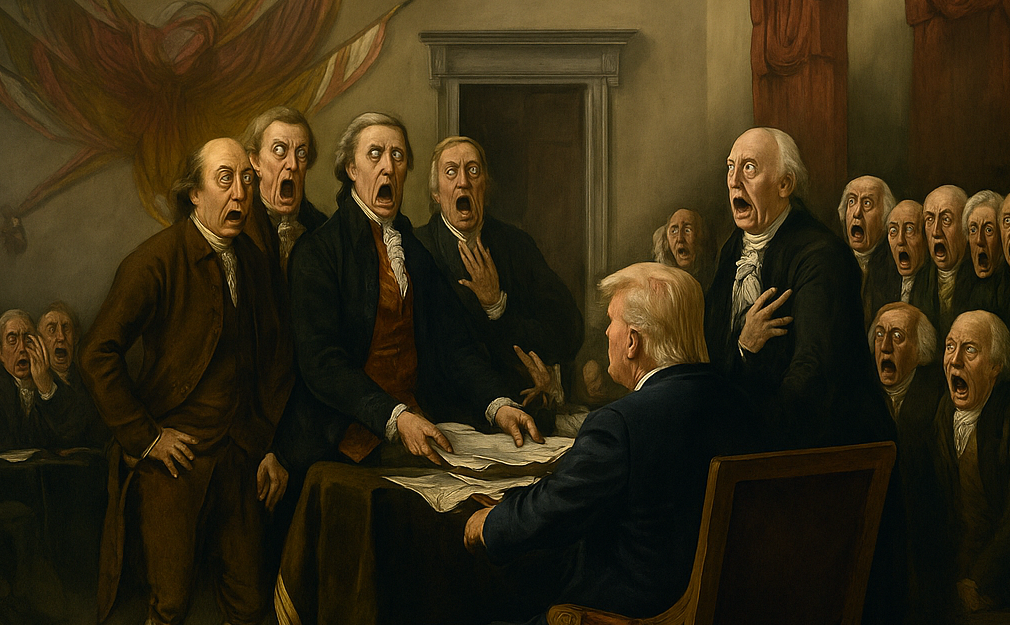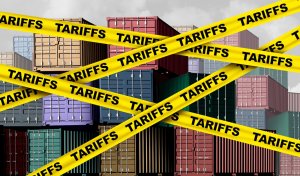Professor Marc Egnal of York University joins the Institute for New Economic Thinking’s Lynn Parramore to explore why historians cling to an inaccurate and misleading narrative, and what we can learn from the real history about tyranny, checks and balances, imperialism — and resistance.
April 19th marks the 250th anniversary of the Revolutionary War’s start, with the first battles taking place in Lexington and Concord, Massachusetts. You’ve probably got a solid idea of what kicked it all off — a fight for liberty, right?
Well, not so fast, says historian Marc Egnal. The “fight for liberty” narrative is a nice story, but it doesn’t quite hold up when you dig into the real reasons behind the American Revolution. Egnal offers a dissenting perspective that challenges the long-accepted view of why the colonies rebelled. His classic book A Mighty Empire (1988) turned the study of the Revolution on its head, arguing that the focus on liberty and freedom missed the mark. Now, in his upcoming book Challenging the Myths of US History, Egnal revisits the Revolution, sticking to the same core idea from his earlier work: the rebellion wasn’t about lofty ideals — it was about territorial and economic expansion.
As we navigate today’s tumultuous moment in the U.S. — from the growing debates over presidential power, checks and balances, and imperialism to the ongoing struggle for economic and social justice —Egnal’s perspective offers a timely reminder of how historical narratives shape – and distort — our view of the present. His work shows how the lofty revolutionary ideals we still celebrate were often used to cover up deeper, more complex forces at play, like economic interests, territorial ambitions, and entrenched inequalities. These same issues continue to echo throughout today’s political landscape. In this conversation, we dive into the origins of the American Revolution and explore how its myths continue to impact how we understand the nation’s past, present, and future.
Lynn Parramore: Your groundbreaking work on the American Revolution, A Mighty Empire, now regarded as a classic of revisionist history, came out in 1988. Now, in Challenging the Myths of US History, you revisit the Revolution. Has your perspective changed over time?
Marc Egnal: Writing A Mighty Empire was a 20-year project, and my views evolved over those years. That book still reflects my core perspective, and that outlook characterizes the one coming out in September as well.
By the 1960s, the traditional view of the American Revolution was largely set, and surprisingly, there hasn’t been much change since then in understanding the causes. While there have been dramatic advances in our understanding of other areas, like the role of common people, the long-accepted reasons for the Revolution remain largely unchallenged. There seems to be a curious lack of interest in revisiting them.
This disturbs me. When I went through graduate school in the 1960s, and when my book came out in 1988, I was dissatisfied with the accepted view—and I still am. That standard outlook can really can be summarized in a word, “liberty.”
When Patrick Henry said – apocryphally – “Give me liberty and or give me death,” that’s not far from the view that historians typically take. The idea of liberty, embodied in what’s known as the Republicanism ideology, has been spelled out in many books. The view persists that the American Revolution was a matter of principle: the English were taxing the Americans without representation and threatening their liberties, and as a result, freedom-loving Americans rebelled. That view, which most historians would have taken in 1970, is still common in 2025. I vigorously dissent.
LP: If liberty wasn’t the core issue, what word might you choose to encapsulate the causes?
ME: Ha! Ok. I wrote a 400-page book, which took me 20 years to write, but I’m gonna boil it down to one word. The first word that comes to mind is “economics” – and that’s important, but I think “expansion” is more accurate. Yes, “expansion” would be my word.
LP: Expansion in what sense?
ME: The timeframe in this story matters a great deal. The Revolutionary Era is typically defined by the period from the Proclamation of 1763, which restricted American colonial expansion west of the Appalachian Mountains, to 1776. That story dwells on various measures: the Sugar Act, the Stamp Act, the Townshend Duties Act, the Tea Party, and the Continental Congresses and Independence. That’s what historians typically look at.
What I argue is that if you’re starting at 1763, it’s like getting into an action movie in the middle. You hear a lot of explosions, and you see people fighting, and it all seems thrilling — but you have no real idea why people are divided and why they’re so incensed.
LP: So we want to rewind the movie a bit.
ME: Yes. My story — and I will stick with the word expansion — goes back to mid-century. The opposing two groups, later known as Patriots and Tories, and which I’ll call expansionists and non-expansionists, are there. Take two leading figures, Ben Franklin and George Washington, who will both become leading Patriots. What are they doing in mid-century? Well, they’re actually siding with the British. They’re both helping them in the French and Indian War. On the one side was France and its Native American allies. On the other was Great Britain and the American colonists. Between 1754 and 1763, Franklin was helping in Pennsylvania, while Washington led a small fighting force near Fort Duquesne, modern-day Pittsburgh. Both Franklin and Washington had a vision of an expansive country, one that’s going to grow economically and territorially.
In the 1750s, and in some cases back in the 1740s, being an expansionist meant siding with the British — not unthinkingly, not unreservedly, but still viewing the British as allies. After 1763, expansionism means opposing the British because the goal for Washington, Franklin, and their followers is the same: to have a rapidly growing country. The British are helping them achieve that goal before 1763, and they’re hindering that quest after 1763. That continuity, which I looked at by researching five different colonies, is right at the heart of understanding the Revolution.
LP: Let’s talk more about how this division between expansionists and non-expansionists played out among the elites in the pre-1763 period. What were the causes?
ME: By 1750, the colonists were divided for three main reasons: geography, economic interests, and religion, which led to the rise of these two groups, expansionists and non-expansionists. Geography created divisions because landowners like Washington, who lived near the Potomac — a river that goes way inland — were invested in defending western territories. Coastal elites, such as those in New York and South Carolina, were less interested in spending money on frontier defense.
Economic interests played a major role. Wealthy merchants like Thomas Hancock, the uncle of John Hancock, often were smugglers or interested in trade outside the confines of the British Empire. Other members of the elite, like Thomas Hutchinson, Royal Governor of Massachusetts (1771–1774) and a descendant of religious dissenter Anne Hutchinson, along with Andrew Oliver, the loyalist Stamp Distributor under the 1765 Stamp Act, focused on trade ties with Britain.
Religion further divided colonists, as religious groups like Quakers and Mennonites in Pennsylvania were more resistant to frontier expansion, while Pennsylvania’s Presbyterians supported it.
So in the mid-18th century, divisions emerged between expansionists, who favored territorial and economic growth, and non-expansionists, who sought to preserve the status quo. For the non-expansionists, the risks simply weren’t worth it. If you focus on figures like Washington and Franklin, you might assume all good Americans supported the British in the French and Indian War, but that wasn’t the case. One key debate was whether legislatures should vote to fund militias. Colonial budgets were tight, and going to war meant heavier taxes. That becomes a big point of division.
These divisions persisted and are crucial to understanding the split after 1763. While the Patriot narrative of “no taxation without representation” is clear, the motivations of loyalists, especially multi-generation Americans like the Hutchinsons, remain puzzling without considering these earlier divisions. Why didn’t they embrace liberty?
LP: Right, as if prominent Americans with deep roots were somehow opposed to liberty.
ME: Yes, and it wasn’t just a matter of a few dissenters; at least 20 percent of the population were loyalists. Debates over expansion—territorial and economic—help explain the complex attitudes, particularly among the upper class, with figures like Franklin and Washington pushing for expansion, but a large group of Americans not sharing that view. This reality is not addressed by historians who insist that liberty was the main case.
LP: Why do you think the liberty narrative took over?
ME: Well, “expansion” sounds so narrowly self-interested, while “liberty” is an uplifting term. Sells much better. But it’s a loaded term, too. Samuel Johnson reportedly said, “Why is that the loudest yelpers after liberty are slaveholders?” With few exceptions, liberty never extended to the slave population, Indigenous Peoples, indentured servants, women, or poor people. It’s a wonderful, noble term, but it’s narrowly defined. It’s really a great spin: if you say you’re fighting for liberty — wow! — this has resonances going all the way back to classical times.
LP: And the Bible.
ME: Yes.
LP: Let’s talk about the role of those who weren’t wealthy, weren’t slaveholders, as highlighted by Howard Zinn and others. How do you assess their contributions to the Revolution, and how were they drawn into allyship with elites?
ME: Over the past 50 years, there’s been less and less interest in the causes of the Revolution, with most viewing it as a settled issue about liberty. At the same time, much important work has explored the experiences of less wealthy groups—white males, women, African Americans, and Indigenous Peoples. This is a valuable and dynamic field, one that I’ve learned a lot from. Yet, at its core, the American Revolution was a colonial revolution, not a class revolution. Unlike the French or Russian Revolutions, it did not bring about a class upheaval. While less wealthy Americans played a crucial role, the Revolution didn’t fundamentally change class relations.
That said, much did change. As tensions with Britain escalated, both Patriots and Tories sought support, especially in the cities. Patriots recruited the artisans and others who worked with their hands, particularly with regard to the non-importation agreements against the Stamp Act and Townshend Duties. That need for support grew when the conflict intensified with the Boston Tea Party in December 1773, and then the Intolerable Acts of 1774, when the Port of Boston was closed. The conflict spread, reaching into the countryside, where both sides reached out to small farmers, just as they had from city artisans.
There’s an interesting dynamic at play with the less wealthy. Artisans and small farmers had largely been excluded from the political process. They weren’t consulted, and in many cases, they had no vote. While the colonies had representative governments, these groups were either excluded or only occasionally consulted. But now, they begin to voice their dissent. Within the states, after independence, new conflicts emerged, driven by the inclusion of these groups in the Revolutionary movement. So it’s not a class revolution, but things are stirred up and they’ll never be the same.
LP: How did the class conflict leading up to the Revolution impact events and the outcome?
ME: We need to examine several conflicts. One is the pre-Revolutionary clash between coastal aristocrats in the Carolinas and Georgia, and backcountry farmers, who were left without courts or defense. The Battle of Alamance took place in 1771, in North Carolina, between the Regulators, as the backcountry farmers were called, and the colonial militia. As the Revolutionary movement culminates in independence, the Regulators in the Carolinas take the view that the enemy of my enemy is my friend. That is, they disliked the Patriotic coastal elite and therefore favored the Crown. Many of the backcountry farmers became loyalists.
Something similar goes on in upstate New York, where the region’s history, shaped by a feudal-style landholding system, created tensions between powerful families like the Livingstons and Rensselaers, and landowners who were not part of the elite and wanted clear, freehold title to their property. Those small farmers, inspired by the rhetoric of liberty and “no taxation without representation,” briefly found themselves in conflict with the Patriots, the Livingstons, who, ironically, called on British troops to quell a revolt among them. By 1775, with the war underway, the less wealthy populations in areas like upstate New York and the backcountry of the Carolinas often sided with the Tories and opposed the Patriots.
LP: You’ve written about the evolving role of women in the Revolution. How does an action like the Edenton Tea Party in North Carolina reflect changes in their political and social involvement?
ME: White women are involved in the non-importation movement in 1768-1770, and the boycotts by American colonists against British goods in response to the Townshend Acts of 1767. That measure imposed taxes on imported goods like glass, paper, and tea. Women start spinning homespun as part of the boycott.
Let’s pause for a moment, with an eye to recent events. These duties were really tariffs, imposed by a foreign country. Tariffs are ultimately taxes on consumption, and the colonists, women and men, didn’t like them.
As a result, you get a slew of newspaper articles and tracts about non-consumption – that is, refusing British products. The women who resist British control are applauded as patriots. All this intensifies in many colonies, including North Carolina. Protests in that colony culminate in October 1774 in Edenton, where 51 women get together and sign a pledge. They become quite the celebrities — even in the British papers. They epitomize what’s going on with women’s increasing involvement in revolutionary politics.
But historians differ on how much women’s place in society changes in this era. There’s still couverture, the legal doctrine that says basically that women disappear in marriage. They have no rights to property. They have no rights to sue or be sued. None of this is really altered during this period. The Marriage Women Property Acts, which strengthened their financial and legal position, are a 19th-century phenomenon. Abigail Adams famously urged her husband, John Adams, in a March 31, 1776, letter to “Remember the Ladies” when shaping the new government, but John basically pooh-poohs it. So, there’s not a lot of legal or political movement. Revolutionary women have their moment of appreciation in the press, and then everybody sort of moves on.
But again, there is change. Women become more active. In New England in particular, literacy expands. New Jersey passed a law in 1776 that allowed women to vote if they met property qualifications. They have the vote for a number of years before it’s restricted. Women are beginning to write and read novels. They’re beginning to express themselves.
So, in non-political ways, and in a few political ways, the Revolution does bring changes for women. Many educational institutions are established after the Revolution, beginning around the turn of the century. Particularly in the North, women are getting more educated. Seneca Falls doesn’t happen until 1848, but there’s a lot happening before Seneca Falls. When Alexis de Tocqueville came to America in 1830, he said, Wow, these are remarkable women. They’re out and about. He writes about how these American women know their own minds long before marriage.
After the Revolution, women also found all sorts of benevolent societies that helped poor widows, indigent people, and so on — a whole benevolent movement. Women were undeniably changed—even without formal political power, until the late 19th century.
LP: The concept of tyranny is popping up in today’s political discourse in the U.S. How did the colonists view tyranny, and how did it shape their stances on the Revolution?
ME: As the Revolution movement intensifies and the fighting breaks out in Lexington and Concord, and Bunker Hill, the Patriot leaders make an interesting shift. At first, their resistance is directed against the oppressive measures passed by Parliament: the Stamp Act, the Townshend Duties, and the Tea Act. But the Declaration of Independence focuses on one person. He did this. And the he, of course, is King George III. So by the time of independence, the Americans — Jefferson and Franklin, who are writing the Declaration and the others who sign it — are really making this a revolution against the tyrant. It’s spin. It means that you’re not fighting against the entire English people.
So tyranny, specifically the tyranny of George III, marks the rhetoric of the Revolution and its aftermath. The Revolutionary Era saw two frameworks of government. The first was the Articles of Confederation, drafted quickly and put into effect right away, though not formally adopted in 1780. With a weak executive, the Articles reflect America’s lingering PTSD from George III’s rule.
From the perspective of many in the upper class, the Articles of Confederation were too weak, especially as they faced increasingly “uppity” farmers in various states. A revolt of small farmers in Massachusetts, Shays’s Rebellion, was the immediate cause for bringing delegates together in Philadelphia in 1787 to create a new, stronger frame of government — the U.S. Constitution.
LP: So, essentially, the Articles reflected the interests of the less affluent, prompting a move to readjust.
ME: Yes, in some ways, the Articles of Confederation better facilitated local democracy than the Constitution, because it allowed the states more latitude to pass their own laws, particularly those protecting debtors. North Carolina freely issued paper money and passed “stay-and-tender” laws, which postponed debt execution and allowed payment in non-legal tender. Rhode Island became the poster child for printing money.
The upper classes realized things had gone too far with the reaction to bad King George, prompting the 1787 Constitutional Convention. They aimed to address two key issues: first, they opposed what they regarded as the laxness of state constitutions, especially those that made it possible to print paper money and offer debt relief. The founders sought a government that would prevent such measures, which led to the inclusion of a clause on respecting contracts. At the same time, having fought against a monarchy, they were determined not to create another one. While Hamilton might not have minded a king, he was an outlier. Ultimately, the delegates established a system of checks and balances, a key feature of the Constitution.
How does this connect to the present? I think the founders would be somewhat horrified by the idea of a president who cowed the legislature, made legislators take a loyalty test, and basically neutered the ability of the legislature to be a check on the president.
The president holds significant powers, much greater than the presiding officer under the Articles of Confederation, but that person is not a king—the founders would have found it abhorrent for somebody to call themselves a king. The concept of tyranny and the system of checks and balances draw heavily from classical ideas of government—monarchy, aristocracy, and democracy. It’s rooted in that tradition and reflects the founders’ deep revulsion and fear of tyranny. All that was shaped by their experiences and historical context.
LP: What’s a key takeaway for us to keep in mind as we approach this anniversary?
ME: First, I’d emphasize continuity. In looking at the current state of affairs, if you really understand the causes of the Revolution, you might be less shocked to see what’s unfolding now.
If you view the Revolution as stemming from territorial and economic expansion rather than lofty ideals—though those ideals were present, they were secondary—you see the continuity. The push for territory, first within the U.S. and then beyond, wasn’t an anomaly. Even the attempt to wield tariffs like a weapon has roots in the founders’ assertiveness.
There’s also continuity in issues of race. The Revolution advanced freedom in the northern states, but it also solidified the U.S. as a slave-holding nation. Slavery and racism were embedded in the Constitution. Racism is still present in today’s government—and so is an aggressive foreign policy, which continues as part of the expansionist mindset. This is part of America’s identity. It’s not the whole story, but understanding these continuities is key to understanding America.
But there’s another continuity, one that has us look in a different direction. It’s what Howard Zinn and other writers have emphasized. And that’s resistance – resistance to racial oppression, to imperialism, and to tyranny. Looking at present-day America, the Constitution isn’t functioning as the founders intended. The checks and balances, central to their vision, are being eroded. But we still have a strong dissenting tradition, which remains a key part of the American story.






